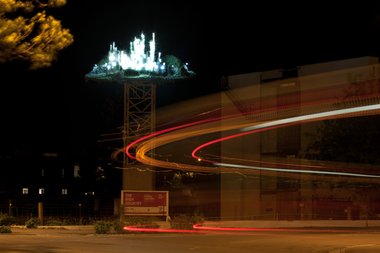Andrew Paul Wood – 20 November, 2012
The High Country is a cityscape of discarded water bottles nestled in rolling green-pastured hills of shredded silage wrapping. At night the city towers are illuminated, a much needed point of interest in an increasingly bland urban environment of demolitions and concrete tilt slab.
Christchurch
Joanna Langford
The High Country
November 2012 to January 2013
And I John saw the holy city, new Jerusalem, coming down from God out of heaven, prepared as a bride adorned for her husband. - Revelation 21:2, King James Version
A city floats above Christchurch like a Fata Morgana or Nephelokokkygia, a little hovering Laputa out of Gulliver’s Travels, or perhaps an echo of sky-poised rock in René Magritte’s Le Château des Pyrénées (1959), or the gravity-resisting Hallelujah Mountains of James Cameron’s 2010 movie Avatar, or the flying city of the Hawkmen in Flash Gordon? What are we to make of this strange apparition from another world beyond the sky? Is it a visitation, a vision, or an omen? Despite its obvious concrete reality, this intervention has obvious dreamlike and mythopoetic qualities that make it something rather special.
Joanna Langford’s The High Country, a belated project of Christchurch’s 2011 SCAPE biennial, like most of her recent work, is an installation made from recycled waste. Perched high above one of Christchurch’s many cleared lots (mercifully not colonised by Wilson’s carparks) on the corner of Montreal and Kilmore Streets off Cranmer Square, on top of a ten metre tall crane tower well-anchored against the aftershocks that still plague the Garden City from time to time. This solid terrestrial bridge, a Tower of Babel, is in contrast to the aerial, ethereal city in the sky.
Born in Gisborne in 1978, Dunedin-based Langford studied Media Arts in Hamilton, and graduated with a Masters in Painting at the University of Canterbury School of Fine Arts in 2004. She was the 2006 Olivia Spencer-Bower Fellow and the 2010 Frances Hodgkins Fellow, University of Otago. Her work is very familiar to the Canterbury audience, particularly from her epic installation Up from the Plainlands which Christchurch Art Gallery commissioned for the top of its majestic central staircase in 2009 - a Dr Seuss-like landscape of the plastic green grass found in deli and butcher’s displays, suspended beneath great billowing inflatable clouds made from white plastic shopping bags. The continuum of aesthetic and ideas are immediately obvious.
The High Country is a cityscape of discarded water bottles nestled in rolling green-pastured hills of shredded silage wrapping. At night the city towers are illuminated, a much needed point of interest in an increasingly bland urban environment of demolitions and concrete tilt slab. A New Jerusalem of recycled materials rises miraculously with the former sites of painfully absent heritage buildings on all sides and the leafy green boscage of Cranmer Square. The unexpected, surreal nature of the intervention is a big part of the work’s charm.
The installation counterpoints the urban - the skyscrapers made of city-dwellers’ ubiquitous sipper drinking bottles - with the rural - the silage wrapping paddocks. It also represents a kind of heavenly city among the clouds, a utopian and superlunary Platonic ideal form. In that sense it might be said to be a reflection of the anticipated future Christchurch that it is hoped will arise Phoenix-like from the rubble. Perhaps then, we should regard this as an aspirational icon, and an ex voto art work giving thanks that the events of September 2010 and February 2011 were not considerably worse. Perhaps it is a beacon of hope as well.
This is the end of a long and difficult saga. Earthquakes postponed the SCAPE Biennial of art in public space for two years in succession, with further delays because of several renegotiations of site and Langford injuring herself this year. The result is a striking work that animates the problematic landscape of post-quake Christchurch. It is one courageous and outstanding solution of how to reinvest life and interest to the desolate and homogenised voids of the inner city during its transitional regeneration.
Andrew Paul Wood





 Advertising in this column
Advertising in this column Two Rooms presents a program of residencies and projects
Two Rooms presents a program of residencies and projects



This Discussion has 0 comments.
Comment
Participate
Register to Participate.
Sign in
Sign in to an existing account.